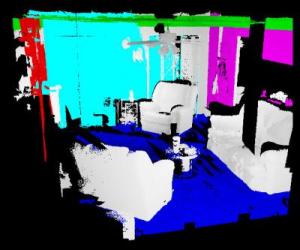May 7 2010
In disaster emergencies, such as the recent West Virginia mine explosion or the earthquake in Haiti, it is often unsafe for responders to enter the scene, prolonging the rescue of potential survivors. Now, University of Missouri researchers have developed software for a robot with a laser sensor that can enter dangerous structures to assess the structure's stability and locate any remaining people. This technology could lead to safer and more efficient rescue missions.
"We are developing computer graphics visualization software to allow the user to interactively navigate the 3-D data captured from the robot's scans," said Ye Duan, associate professor of computer science in the MU College of Engineering. "I worked with my students to develop computer software that helps the user to analyze the data and conduct virtual navigation, so they can have an idea of the structure before they enter it. The technology could save the lives of disaster victims and responders."
 When inside the structure, the robot takes multiple scans using LIDAR that takes up to 500,000 point measurements per second. In this 3-D map the floor is identified by blue, the ceiling by green and the vertical walls by red, cyan and magenta.
When inside the structure, the robot takes multiple scans using LIDAR that takes up to 500,000 point measurements per second. In this 3-D map the floor is identified by blue, the ceiling by green and the vertical walls by red, cyan and magenta.
The remote-controlled robot, built by researchers at the Missouri University of Science and Technology, is designed to remotely transport a Light Detection and Ranging unit (LIDAR) so that responders, such as police, military, firefighters, and search and rescue teams, can know more about dangerous structures before entering. When inside the structure, the robot takes multiple scans using LIDAR that takes up to 500,000 point measurements per second. It also can scan through walls and windows. After the scans, the software forms the data points into sophisticated 3-D maps that can show individual objects, create floorplans and color-code areas inside the structure for stability. Depending on the data size, the data maps can take up from half hour to two hours for the software to create.
"Although the software and the robot can help in emergency situations, it could be commercialized for a variety of uses," Duan said. "This system could be used for routine structure inspections, which could help prevent tragedies such as the Minneapolis bridge collapse in 2007. It also could allow the military to perform unmanned terrain acquisition to reduce wartime casualties."
The researchers now are working on a proposal to make the robot faster and smaller than the current model, which resembles the NASA rovers sent to Mars, which weighs about 200 pounds.
Duan's research has been published in International Journal of CAD/CAM. The robot recently was named on the list of Kiplinger's "8 Robots That Will Change Your Life." Duan collaborated with MU students Kevin Karsh and Yongjian Xi, who developed the software and algorithms; Norbert Maerz, associate professor of geological engineering at Missouri S&T; and Missouri S&T students Travis Kassebaum, Kiernan Shea and Darrell Williams.